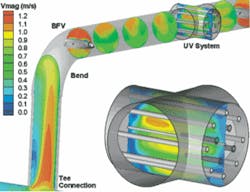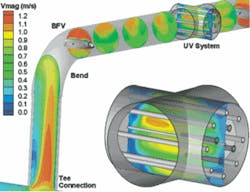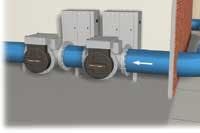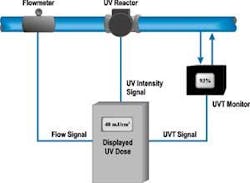New EPA Rule to Drive use of UV Disinfection
Now that the Long Term 2 Enhanced Surface Water Treatment Rule (LT2ESWTR or the Rule) will become effective March 6, many drinking water utilities are looking at UV disinfection as the best available technology for meeting their Cryptosporidium inactivation requirements and goals. Although it is a relatively new technology, UV disinfection is proving itself in plants across the United States and Canada as a practical and highly effective option for water treatment.
Briefly, the long-term Rule calls for:
• Monitoring of source water for Cryptosporidium;
• Risk-targeted treatment of source waters with high Cryptosporidium levels;
• Inactivation of Cryptosporidium by all unfiltered systems;
• Criteria for the use of Cryptosporidium treatment and control processes; and
• Covering or treating of uncovered finished water storage facilities.
Administering, Validating Proper Dose Levels
If you are considering UV disinfection, the Rule specifies UV dose levels needed for up to 4 log credit of Cryptosporidium, Giardia, and virus. Utilities using disinfection will base their credit on the UV dose indicated by an on-line dose monitoring system. This dose-monitoring algorithm will be proven through validation testing over a range of flow, water UV transmittance, and UV lamp output. UV systems must operate within the validated range as indicated by on-line measurements of flow, UV intensity, lamp on/off status, and UV transmittance. The regulation also requires (1) regular calibration checks of UV sensors used to monitor dose delivery and (2) UV system operation that ensures at least 95 percent of the water is treated within the validated range at the required UV dose.
Inactivation Credits
The Cryptosporidium inactivation requirements of the LT2ESWTR are not the only reasons to implement UV disinfection. Utilities can use UV disinfection for Giardia inactivation credit and base chemical disinfection on virus CT requirements. This approach may be especially attractive to utilities with disinfection by-product (DBP) or chlorine contactor capacity issues. However, since Giardia is sensitive to UV light compared to many waterborne pathogens, conventional or direct filter plants that use UV light instead of chemical disinfection to receive Giardia credit should select a higher UV dose than recommended by the LT2ESWTR for 0.5 or 1.0 log Giardia credit. This higher UV dose will provide disinfection over a wide range of waterborne pathogens, including emerging pathogens such as Mycobacterium avium complex (MAC), which are highly resistant to chemical disinfection but susceptible to UV light. A UV dose of 40 mJ/cm2, recognized by the UV industry as providing 4 log inactivation for a wide range of waterborne pathogens, is recommended for providing multi-barrier disinfection using UV light.
UV and Peroxide for Taste and Odor Problems
Utilities can also address issues with taste and odor by using UV light combined with peroxide. This emerging technology treats taste and odor compounds such as MIB and geosmin and pesticides like atrazine. With this application, you can size the UV reactors to deliver high UV doses needed for micro-pollutant destruction. Those UV doses are typically over an order of magnitude greater than the doses required for Cryptosporidium and Giardia credit. However, the UV system would operate at low UV doses needed to provide disinfection credit most of the time, and turn on extra reactors and UV lamps as needed to provide the high UV doses needed to provide treatment during a taste and odor event.
EPA Guidance Manual Contains Practical Advice for Utilities
Since UV disinfection is a relatively new technology, several groups have taken the lead on researching, testing, and implementing UV systems, and then communicating the data so water treatment authorities can make informed choices and decisions.
To support the implementation of UV disinfection, USEPA is releasing the UV Disinfection Guidance Manual (UVDGM). The UVDGM provides guidance on the implementation of UV disinfection addressing design, operation, dose monitoring, and validation.
Various organizations have also stepped up to the plate to help utilities implement UV disinfection in accordance with USEPA requirements and guidance. UV validation test facilities have been developed in Portland, OR, and Jonestown, NY, to provide testing of UV reactors for flows up to 40 mgd and UV transmittance from 70 to 98 percent.
UV vendors themselves have responded to the new opportunities in drinking water by developing new commercial UV technologies that include large scale UV reactors (> 40mgd), high efficiency LPHO and MP UV lamps, germicidal UV sensors, physical-chemical quartz sleeve cleaning systems, and advanced UV dose monitoring and dose-pacing algorithms. Currently, there are at least 30 UV systems available on the market with validated dose delivery and monitoring for drinking water applications.
UV Research
Research foundations such as AwwaRF and NYSERDA have also developed strong research programs on UV disinfection with practical results.
• The soon-to-be-published AwwaRF Tailored Collaboration Optimization of UV Validation has developed new approaches for UV reactor validation that will significantly reduce the capital and O&M costs of UV reactor implementation.
• The NYSERDA/AwwaRF project Optimization of UV Disinfection has developed a software tool, UVCAT, for predicting UV system performance, costs, and public health protection, thereby providing answers on the best approaches for controlling dose delivery and mitigating off-specification performance.
• An AwwaRF project on UV sensor systems will provide a CFD-based tool capable of assessing the impact of hydraulics on dose delivery with a given UV system installation.
• Another AwwaRF project, Development of a UV Knowledgebase, will survey up to 145 UV system installations in North America, documenting their design, operation, reliability, costs, and lessons learned.
About the Author:
Harold Wright is a Research Engineer for Carollo Engineers in Boise, ID. He has over 18 years experience in environmental engineering with expertise in UV Disinfection, Disinfection Systems, and Water Quality Evaluations. He holds a BS in Engineering Physics and an MS in Environmental Engineering. He may be contacted via-email at [email protected].




